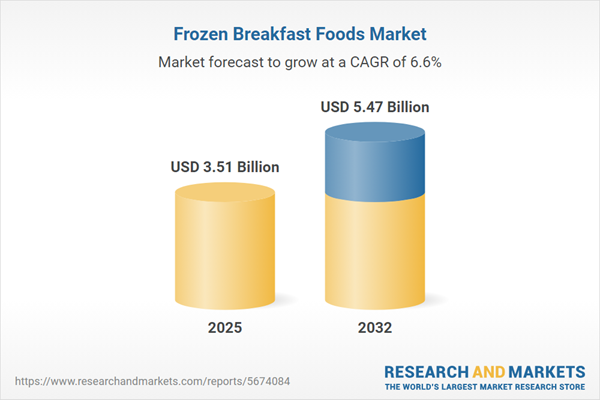Speak directly to the analyst to clarify any post sales queries you may have.
The frozen breakfast foods market is experiencing rapid evolution, driven by changing lifestyles and higher expectations for both nutrition and convenience. Senior decision-makers must navigate new opportunities and challenges across product innovation, supply chain resilience, and fast-shifting consumer demands.
Market Snapshot: Frozen Breakfast Foods Market Overview
The Frozen Breakfast Foods Market grew from USD 3.29 billion in 2024 to USD 3.51 billion in 2025. Forecasts project continued expansion at a CAGR of 6.55%, with the market expected to reach USD 5.47 billion by 2032. This growth is driven by demand for convenient breakfast solutions that align with trends in health, wellness, and digital purchasing habits.
Scope & Segmentation of the Frozen Breakfast Foods Market
- Product Types: Bowls, Burritos, Pancakes, Sandwiches (Egg Sandwich, Sausage Sandwich), Waffles (Belgian, Regular)
- Packaging Types: Bag, Box, Tray, Wrapper
- Distribution Channels: Offline Retail (Convenience Stores, Supermarkets, Hypermarkets), Online Retail (Direct To Consumer, Third Party)
- End Users: Foodservice, Household
- Geographic Regions: Americas (North America, Latin America), Europe, Middle East & Africa (Europe, Middle East, Africa), Asia-Pacific (China, India, Japan, Australia, South Korea, Indonesia, Thailand, Malaysia, Singapore, Taiwan, and others)
- Marketplace Players: The Kellogg Company, General Mills Inc., Conagra Brands Inc., Nestlé S.A., Tyson Foods Inc., McCain Foods Limited, J&J Snack Foods Corp., Walmart Inc., The Kroger Co., Costco Wholesale Corporation
Key Takeaways for Senior Decision-Makers
- Innovation is accelerating as brands introduce high-protein, plant-forward, and clean-label options to differentiate and capture emerging health-oriented segments.
- Consumer expectations for sustainable packaging and transparent sourcing have set new benchmarks, leading to investment in recyclable materials and cleaner formulations.
- The digitalization of retail through direct-to-consumer and third-party marketplaces has widened access to frozen breakfast products and enabled more personalized marketing strategies.
- Shifting end-user needs between foodservice and at-home consumption are prompting manufacturers to adapt packaging formats, portion sizes, and flavor profiles.
- Regional variations in cold chain logistics and retail infrastructure are influencing go-to-market strategies and product positioning across global markets.
- Mergers, acquisitions, and collaborative technology ventures are helping leading companies respond more nimbly to market changes and secure supply chain strengths.
Tariff Impact: Navigating Supply Chain and Pricing Pressures
Heightened tariffs in the United States on imported ingredients have increased cost pressures throughout the frozen breakfast food supply chain. To address these challenges, industry players are diversifying sourcing strategies, regionalizing production, and implementing targeted price management. Strategic procurement and scenario planning are essential to maintain margin stability while navigating ongoing trade policy changes.
Methodology & Data Sources
This report is grounded in comprehensive primary research, including detailed interviews with industry executives, and robust secondary research across government databases, company disclosures, and trade publications. Data triangulation ensures the accuracy and relevance of supply chain, pricing, and distribution insights.
Why This Report Matters
- Enables strategic planning through detailed segmentation and regional analysis relevant to evolving consumer and regulatory trends.
- Delivers actionable insight into supply chain optimization and competitive strategies in response to market disruptions such as tariffs and changing technology use.
- Facilitates effective market entry and expansion decisions by providing a thorough understanding of growth drivers across retail channels, product types, and global regions.
Conclusion
The market for frozen breakfast foods is defined by dynamic shifts in consumer preference, supply chain strategies, and competitive innovation. Stakeholders that adapt product offerings and channel approaches are positioned for long-term growth and value creation in this evolving landscape.
Additional Product Information:
- Purchase of this report includes 1 year online access with quarterly updates.
- This report can be updated on request. Please contact our Customer Experience team using the Ask a Question widget on our website.
Table of Contents
3. Executive Summary
4. Market Overview
7. Cumulative Impact of Artificial Intelligence 2025
Companies Mentioned
The companies profiled in this Frozen Breakfast Foods market report include:- The Kellogg Company
- General Mills, Inc.
- Conagra Brands, Inc.
- Nestlé S.A.
- Tyson Foods, Inc.
- McCain Foods Limited
- J&J Snacks Foods Corp.
- Walmart Inc.
- The Kroger Co.
- Costco Wholesale Corporation
Table Information
| Report Attribute | Details |
|---|---|
| No. of Pages | 182 |
| Published | October 2025 |
| Forecast Period | 2025 - 2032 |
| Estimated Market Value ( USD | $ 3.51 Billion |
| Forecasted Market Value ( USD | $ 5.47 Billion |
| Compound Annual Growth Rate | 6.5% |
| Regions Covered | Global |
| No. of Companies Mentioned | 11 |









